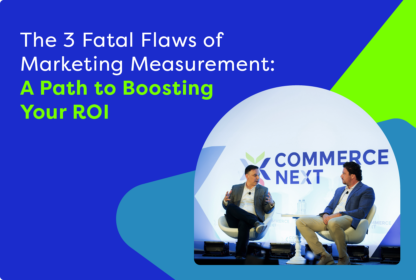1. Introduction
In the ever-evolving marketing landscape, where digital strategies dominate the conversation, it’s easy to overlook the enduring power of more traditional methods like direct mail marketing. However, while digital marketing has undoubtedly revolutionized the way in which we connect with audiences, the allure of direct mail remains steadfast.
The tactile nature of a physical piece of mail carries a distinct advantage – it engages multiple senses and creates a tangible connection that digital counterparts struggle to replicate. Direct mail also boasts an impressive track record of trustworthiness and effectiveness, largely thanks to being a fully addressable marketing channel.
But direct mail does have its limitations. It lacks the real-time relevance and performance-driven strategies that define the digital landscape. Measuring the immediate impact of a direct mail campaign can be challenging, making it harder to fine-tune strategies in an agile fashion. It also offers less in the way of automation and dynamic workflows, making it slower and less flexible than modern marketers would like.
Which is where Programmatic Direct Mail comes into play.
Programmatic Direct Mail is a performance marketing channel that leverages machine learning and automation. It’s informed by massive sets of real-time intent and offline data to engage consumers at home with highly relevant physical media, offering a marriage of data and physical engagement poised to usher in a new era of marketing innovation.
This guide will help you understand the impact of digital fatigue on marketing ROI, the key differences between traditional direct mail and PDM, and the relevance of PDM across the entire customer journey. We’ll also explore the elements that make PDM a cash-flow positive strategy and offer guidance on selecting the ideal PDM partner.
Let’s jump in!
2. Addressing Today’s Digital Marketing Challenges
We may not have been sucked into the metaverse quite yet, but we spend more time online as a species than ever before. And our digitally-dominated lifestyles invite more challenges for marketers than you might think. Sure, it’s never been easier to get an ad in front of a set of eyeballs. But that accessibility has also drastically increased competition and, consequently, exhausted consumers.
Every day online, we’re inundated by ads. This constant bombardment has led to consumers developing ‘ad-immunity,’ making it tougher for marketers to make a connection. Moreover, the phasing out of digital identifiers like cookies has greatly reduced the addressability of audiences in some digital channels, hindering precision targeting and measurement capabilities and resulting in lower reach and higher costs.
The idea of receiving a marketing message through your mailbox may feel antiquated, but it’s actually just as effective as digital marketing, if not more so. For every $1.27 spent on direct mail, the average return on investment is $4.09. Relative to email’s response rate of 0.6%, direct mail’s typical response rate ranges from 2.7% to 4.4%. In addition, 73% of American consumers prefer being reached by brands via direct mail. That’s primarily because they can engage with direct mail at their convenience, on their terms.
Scientific studies underscore the influence of physical mail over digital marketing. In research conducted by the Canadian Post and True Impact, they found:
- Consumers recall physical ads 70% more than digital ones, making direct mail more memorable.
- Direct mail requires 21% less mental effort to process, making marketing messages easier to understand.
- Direct mail is more persuasive: respondents show 20% higher motivation. This spikes notably if the mailer engages senses beyond touch.
Of course, direct mail isn’t perfect. Far from it.
Direct mail can involve slower and more cumbersome processes, often requiring multiple vendors and months of lead-up time. Secondly, it is less relevant to consumers than more targeted digital marketing since it doesn’t factor in real-time browsing and buying behaviors. Finally, direct mail does not offer the same kinds of immediate insights into performance and pacing as other marketing channels, making it nearly impossible to know how the campaign is actually performing until it is long since over.
So, while direct mail is still a very effective and important marketing tool, it lacks the critical criteria required to fit into the agile, performance-driven marketing mix many modern marketers deploy today.
3. PDM and Where It Fits in the Direct Mail Ecosystem
Programmatic Direct Mail (PDM) is part of an industry-wide trend of emerging “offline” or “hybrid” digital channels. First introduced in 2014 by PebblePost, PDM capitalizes on the strengths of both modern digital marketing and a traditional, high-impact format, much like Connected Television (CTV) and Digital-Out-of-Home (DOOH) do.
By merging the precision, speed, and relevance of digital with the compelling influence of physical mail, PDM connects the dots between a user’s online activity and physical postal address to deliver relevant messaging right to a consumer’s mailbox.
But it’s more than retargeting website visitors. It’s about engaging people when and where they make their most important purchase decisions with relevance and respect.
Whether it’s acquiring new customers by modeling “lookalike” audiences of net-new prospects, retargeting consumers active on your website while they are still in-market, or growing and retaining existing customer relationships, PDM allows for a more agile and performance-driven approach. In essence, PDM is about optimizing the audience we engage with, not just the channel we use.
The Direct Mail Ecosystem
Before diving deeper into the specifics of Programmatic Direct Mail as a solution, it’s crucial to understand where and how PDM fits into the current landscape of direct mail. Not every advancement in direct mail technology involves PDM, so it’s important to discern the strengths and limitations of each solution type.
- Gifting Platforms. Platforms like Alyce act as a single stop for corporate and customer gifting. Data analytics, gift selection, customization, order tracking, and delivery are typical features.
- Direct Mail Agencies. Similar to other forms of advertising, direct mail agencies like Gunderson Direct and Belardi Wong work one-on-one with brands to execute direct mail campaigns, from creative and copy work to printing and mailing.
- Direct Mail Automation and Logistics: Tools such as LOB incorporate automation, sales, and tracking functionality into direct mail campaigns. These platforms can also seamlessly integrate with your CRM system, enabling efficient sending and tracking of your direct mail initiatives.
- Trigger-Based Retargeters. These platforms automatically send out pieces of direct mail based on certain customer triggers. Visiting your website, abandoning a shopping cart, or canceling a subscription are typical examples of trigger-based retargeting.
- True PDM Platforms. With the exception of gifting, which tends to be a category unto itself, a full-fledged PDM platform, like PebblePost, can perform most or all of the functionality of the above solutions but with a deeper focus on speed, audience modeling, performance optimization, and analytics.
While many companies in the direct mail space perform point solutions admirably, true PDM platforms provide brands with a holistic, end-to-end approach that goes far beyond basic automation. Programmatic Direct Mail can handle the entire customer lifecycle, from education and intent to retention and lifetime value.
4. PDM Throughout the Customer Lifecycle
Programmatic Direct Mail enables brands to deliver highly relevant messages to audiences throughout the customer lifecycle. When used correctly and with the help of the right partner, PDM can help nurture consumers, increase customer loyalty, and boost sales. Here’s a closer look at how you can use PDM throughout the entire customer lifecycle.
- Prospect New Audiences. Programmatic Direct Mail enables you to identify and engage audiences of net-new customers based on their demographic data and past transactions, as well as their active purchase intent, opening up opportunities to launch a new product, drive in-store foot traffic, or encourage first purchases with greater relevance and efficiency.
- Nurture Consumers. Programmatic Direct Mail enables you to maintain a physical presence with consumers in the midst of a longer consideration cycle. On average, a piece of marketing mail can live on someone’s counter or fridge for up to 17 days. By providing them with tailored educational content or updates about your offerings, you nurture their readiness to engage, paving the way for future conversions.
- Convert Active Shoppers. Programmatic Direct Mail enables retargeting of website visitors, either based on their overall intent or by taking a specific action. PDM platforms allow you to dynamically identify and engage visitors whether or not they’re already in your CRM. So you can send special offers to first-time visitors that didn’t convert or engage loyal customers with personalized offers based on their previous purchases or interests.
- Boost Customer Loyalty. Once someone becomes a customer, Programmatic Direct Mail can help you keep them engaged and coming back for more. For example, you could easily send birthday offers based on their age and life stage or boost sales around major seasonal events like Holiday Shopping, Back to School, or Valentine’s Day. With PDM, maintaining customer loyalty is a precise, well-crafted, personalized effort yielding high conversions.
- Re-engage Lapsed Customers. PDM partners like PebblePost can optimize large lists of customers or leads based on the characteristics and behaviors of your most valued customers, their active purchase intent, and how likely they are to engage with the PDM channel. The benefit? It allows you to focus on those most likely to convert with messages that offer special deals or incentives without wasting budget on customers that were never coming back.
PDM’s effectiveness lies in its ability to understand where each individual is in their customer journey and lifecycle, delivering the messages most likely to catalyze conversion, and adapting communication over time. Upon a purchase, a PDM platform like PebblePost automatically moderates the frequency of physical mailers, ensuring customers aren’t subjected to over-saturation.
Implementing these kinds of company, customer, and scenario-specific PDM strategies makes choosing the right partner extremely critical. You’ll need to take multiple factors into consideration when selecting the right partner to fit your brand, support needs, and target customer profile.
5. Choosing the Perfect Programmatic Direct Mail Partner
There are several key factors to consider when finding the perfect Programmatic Direct Mail partner. You’ll want to consider the size and scope of your initial PDM program, your target audience persona, and your technology stack. And, of course, you’ll want to secure a partner with deep domain expertise and experience in PDM. Not to mention successful past clients in a similar industry or business case as yours.
With those considerations in mind, here are some major checkpoints to consider when choosing a partner.
- Experience. Take a look at the partner’s track record with Programmatic Direct Mail implementations and execution. An outstanding PDM campaign contains many moving parts, so when speaking with them, find out about how well-versed they are in PDM processes. Consider speaking directly to past or current clients about their experience.
- Data Integration. Ask potential partners about data integration, application programming interfaces (APIs), and data sources they’ve worked with. A good Programmatic Direct Mail partner can integrate your data with their system, making it easy to model, target, optimize, and even suppress audiences.
- Support Level. Things happen throughout the course of any Programmatic Direct Mail implementation, campaign, or reporting. Knowing that your partner will be there to help troubleshoot any issues if necessary is critical. Consider your organization’s internal expertise in PDM and digital marketing, and ensure your partner can support you accordingly.
- Real-Time Data. Because PDM is digitally integrated, you’ll have access to real-time data about customer activity, interest, and purchases. Not all Programmatic Direct Mail partners provide the same level of speed, detail, and insights into real-time data. Your PDM partner should give you quality data as fast as possible.
- Budget and ROI. Keep in mind that best-of-breed PDM partners may have a higher average CPP than what you might be used to with traditional direct mail, but it will likely yield a higher ROI over time and will only increase in efficiency as it continues to optimize and scale.
By taking into account a potential partner’s track record, support expertise, and data capabilities, you’ll hone in on a fantastic PDM partner in short order.
6. Key Takeaways
Here are some key takeaways to take along your PDM journey.
- Digital Fatigue is a Huge Challenge. Your target audience is inundated by a tsunami of digital advertising every day. Many are using ad blockers, advanced email filters or have simply grown immune to digital ads altogether.
- Consumers Find Physical Mail Memorable. Direct mail is one of the best ways to combat digital fatigue. Research shows that consumers have better brand recall, purchase intent levels, and conversion rates. Direct mail has a much longer half-life than digital ads.
- Direct Mail and Programmatic Direct Mail are Distinct. Traditional direct mail offers a lot of great benefits, but for performance-driven marketing, PDM engages ready-to-buy consumers at crucial buying stages, significantly boosting conversions and revenue.
- PDM Covers the Customer Lifecycle. It’s possible to engage customers throughout the entire lifecycle using Programmatic Direct Mail. With PDM, you can acquire new customers, increase loyalty, boost revenue, and re-engage lapsed customers.
- Do Your PDM Partner Due Diligence. Great PDM campaigns require experience, support, and technical capabilities. Validate that your partner is a guru in PDM and that they’ve gotten great results for others. Ensure that you get up-to-the-second data and insights for all ongoing PDM campaigns.
Programmatic Direct Mail is a powerful channel that (when used correctly) can fuel incredible growth for your brand. PDM isn’t just another strategy in an era of increasing digital fatigue. It’s a data-driven marketing cornerstone. With PDM, your brand shifts from being just another ad to becoming a familiar and trusted presence. Adopt PDM, and seize the opportunity to redefine your marketing success with PebblePost today.
Unlock the power of Programmatic Direct Mail today. Speak with a PebblePost PDM expert today to discuss the perfect solution for your brand!



